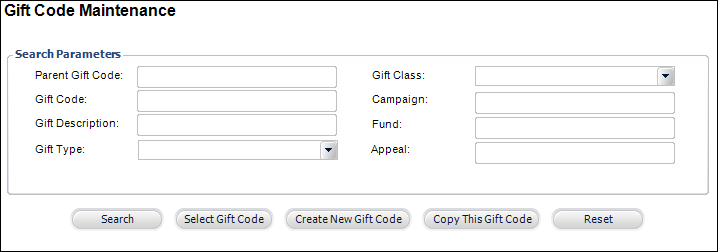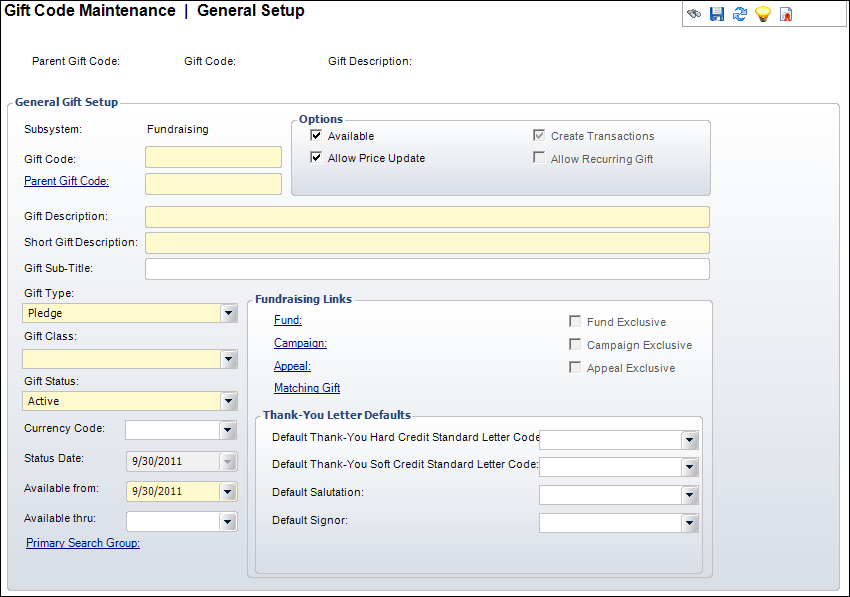The Gift Code Maintenance screen displays, as shown below.

The General Gift screen allows you to define donations and gifts involving transfer of property, stock, and in-kind gifts and services. In the “product” concept of fundraising, you record gifts that are not the transferring of money, but rather the handling of products.
To define the general fundraising gift:
1. Select Fundraising Setup > Fundraising Launch from the main toolbar.
2. Click
Define Gift Codes from the Fundraising
Setup task category.
The Gift Code Maintenance screen displays, as shown below.

3. Click
Create New Gift Code.
The Gift Code Maintenance screen displays, as shown below.

4. Enter
the Gift Code.
The Parent Gift Code defaults to the same value.
5. Enter
the Gift Description.
The Short Gift Description defaults
to the same value.
6. Enter a Gift Sub-Title (used optionally on the Web).
7. Select
the Gift Type from the drop-down
menu.
The type selected here will determine which options are enabled in the
Fundraising Links and Options sections, as well as the Account Detail
section on the General Ledger Accounts screen.
8. Select the Gift Class from the drop-down menu.
9. Select the Gift Status from the drop-down menu.
10. Select the Currency Code from the drop-down menu.
11. Select the Available from date from the drop-down menu.
 The
Available From date cannot be changed if orders have already been created
for it.
The
Available From date cannot be changed if orders have already been created
for it.
12. If necessary, select the Available thru date from the drop-down menu.
13. If necessary, click the Primary Search Group link and search for a Primary Search Group to link to the product.
14. Select the applicable Options checkboxes:
· Available
· Allow Price Update
· Create Transactions
· Allow Recurring Gift
15. Click the Fund link and search for an existing fund to associate with the gift.
16. Click the Campaign link and search for an existing campaign to associate with the gift.
17. Click the Appeal link and search for an existing appeal to associate with the gift.
18. Click the Matching Gift link and search for an existing gift to associate with the gift.
19. Check the appropriate checkboxes if the fund, campaign, and/or appeal are exclusive. The checkboxes are only enabled if a fund/campaign/appeal is selected.
20. From the Thank You Letter Defaults section, if a letter will be used for all donations for this Gift Code, perform the following:
a. Select
the Default Thank You Hard Credit Standard
Letter Code from the drop-down.
This is the letter code for all hard credit acknowledgement merge letters
for the donation.
b. Select
the Default Thank You Soft Credit Standard
Letter Code from the drop-down.
This is the letter code for all soft credit acknowledgement merge letters
for the donation.
c. Select the Default Salutation from the drop-down for the selected Letter Code.
d. Select the Default Signor from the drop-down for the selected Letter Code.
21. Click Save.
| Screen Element | Description |
|---|---|
General Gift Setup |
|
| Subsystem | Read-only. The area, or module, with which the gift is associated. |
| Gift Code | Text box. The unique code for the fundraising gift. Typically, this code is defined to identify the type of donation, such as Pledge, Cash, or In-kind. For master products, the Parent Product is the same as the Gift Code. This code must be unique and can be alphanumeric up to 24 characters. |
| Parent Gift Code | Link and Text box. For master gifts, the Parent Gift Code is the same as the Gift Code. This can be defined as a campaign or fund if the organization wants to define separate gifts for each campaign or fund. Using this method, different GL accounts can be defined. This code must be unique and can be alphanumeric up to 24 characters. |
| Gift Description | Text box. Describes the fundraising gift description. This is an alphanumeric field with approximately 120 characters. |
| Short Gift Description | Text box. Defaults to the Gift Description. If your Gift Description is extraordinarily long, you can edit the Short Gift Description up to 50 characters. If the Short Gift Description is longer than 50 characters, it will be cropped off the invoice. |
| Gift Sub-Title | Text box. This sub-title of the gift is used optionally on the Web. |
| Gift Type | Drop-down. The primary type of gift. These type codes are fixed system codes and control what information needs to be defined for each type of gift. The type selected here defines whether a hard or soft credit should be generated. It also affects the choices for Gift Class. Fundraising gift types include:
Business Rules:
|
| Gift Class | Drop-down. Used to classify any gift (master or sub-product). The only gift class available for fundraising is “Donation.” |
| Gift Status | Drop-down. The status of the gift. Values include Active, Cancelled, and Discontinued. |
| Currency Code | Drop-down. The appropriate domestic or international currency to use in this subsystem, e.g., German Mark, Japanese Yen, US Dollar. |
| Status Date | Read-only. System-generated status change date. |
| Available from | Drop-down. Defaults to the system date, but it can be overridden. The date from which the gift will be available from. |
| Available thru | Drop-down. This field is usually left blank unless there is a specific date on which the gift will not be available. The gift is not available for donations after this date. |
| Primary Search Group | Link. This is an optional feature that allows organizations to assign a search group code to products and customers, so that back-office staff assigned to that primary search group can optionally pre-filter searches for customers or products by their assigned primary search group. Primary search group codes are defined on subgroup customer records and mapped to zip codes. An organization can have customers be automatically assigned to a primary search group based on the zip code of their primary address by setting the "CUS" "AUTOMATIC_SEARCH_GROUP_ASSIGNMENT" application parameter to "Y". |
Options |
|
| Available | Checkbox. Sets this as an active gift for purchase by constituents. |
| Allow Price Update | Checkbox. If this checkbox is selected, the Unit Price field is editable on the Order Entry screen and the Line Item Details screen.
If the price of the product is $0 and this checkbox is selected, the Line Status will default to Proforma regardless of the Org Unit Line Status default. The system assumes that the price will be manually changed.
|
| Create Transactions | Checkbox. Default checked and cannot be changed. Depending on the Gift Type selected, this checkbox may be disabled. When checked, the system automatically makes the order line active and saves the order. |
| Allow Recurring Gift | Checkbox. When checked, allows the gift to be set up as a recurring gift. Recurring gifts are repeatable donations of set amounts over an unset period of time. For example, a donor can be set up with a recurring gift that allows them to pay $15 every month until they decide to cancel the recurring gift. |
Fundraising Links |
|
| Fund | Link. If a fund is identified at the gift-level, it defaults to the Fund field on the Order Entry screen. |
| Campaign | Link. If a campaign is identified at the gift-level, it defaults to the Campaign field on the Order Entry screen. |
| Appeal | Link. If an appeal is identified at the gift-level, it defaults to the Appeal field on the Order Entry screen. |
| Matching Gift | Link. The product that will be used to create a matching gift pledge if the donor is an employee of the company committed to matching employee donations. When a donor makes a contribution that is eligible to be matched under the employer’s matching gift plan, the matching gift pledge selected here is automatically created. Once you link a matching gift to a Fundraising gift, you can click this link to view more details about the selected matching gift in Gift Code Maintenance. |
| Fund Exclusive | Checkbox. If checked, the fund defaults into the order line and cannot be changed. If unchecked, the fund can be changed at the order line level. This checkbox is only enabled if a fund is selected by clicking the Fund link. |
| Campaign Exclusive | Checkbox. If checked, the campaign defaults into the order line and cannot be changed. If unchecked, the campaign can be changed at the order line level. This checkbox is only enabled if a campaign is selected by clicking the Campaign link. |
| Appeal Exclusive | Checkbox. If checked, the appeal defaults into the order line and cannot be changed. If unchecked, the appeal can be changed at the order line level. This checkbox is only enabled if an appeal is selected by clicking the Appeal link. |
Thank You Letter Defaults |
|
| Default Thank You Hard Credit Standard Letter Code | Drop-down. The letter codes that are available for hard credits. |
| Default Thank You Soft Credit Standard Letter Code | Drop-down. The letter codes that are available for soft credits. |
| Default Salutation | Drop-down. The default salutation code for the selected Letter Code. Values are populated based on the non-fixed CUS "CUS_SALUTATION" system type. |
| Default Signor | Drop-down. The default signor code for the selected Letter Code. Values are populated based on the non-fixed FND "ACK_LETTER_SIGNOR" system type. |